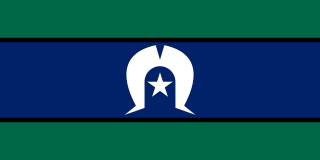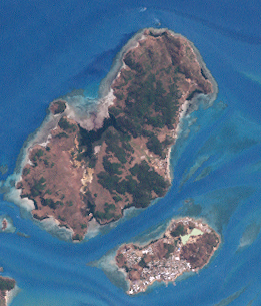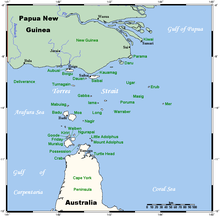Torres Island historical context
The Kaurareg lie in the lower Western island group among the 5 basic ethno-culturally distinct groups that constituted the traditional world of the Torres Strait Islanders, the others being the Saibailgal, Dœwanalgal and Bœigulgal (Top West islanders), the Maluigal (Mid-West islanders), Kulkalgal (Central Islanders) and Meriam Le (Eastern Islanders). Though internecine conflict was chronic in the region, it did not disrupt the dynamic interlocking family, clan and trading system that linked all in a far-flung exchange system, whose goods extended beyond the islands creating a flow of goods between New Guinea and Cape York Peninsula. The Kaurareg and the Mua traded bu (trumpet shells), alup (bailer shells) and wap (turtle and dugong harpoon shafts) for Papuan canoe hulls, cassowary bone-tipped arrows and bamboo for various purposes, such as carrying water and making knives for beheading enemies (upi).
The Kaurareg had close links with the tribes of northern Cape York, which was home to a number of Aboriginal groups. These were the Gudang whose territory extended from Cape York to Fly Point; the Gumakudin whose land was to the southwest of Cape York; the Unduyamo who were in the northern part of Newcastle Bay, and the Yadhaigana whose country went from Jackey Jackey Creek to Escape River. A.C.Haddon, surveying the field reports of the ethnography to date, esp. the narratives collected by Gunnar Landtman, classified the Kaurareg as descendants of the ancient Hiamu people of the island of Daru off the southern Papuan coast. These Hiamu in turn, according to folk history, had come from Iama in the Bourke Isles. The Hiamu, it was said, were repeatedly worsted in encounters with Kiwai invaders, and abandoned Daru and moved to Muralag.
History of contact with westerners
The Kaurareg people were extensively documented before their decimation and the destruction of their traditional life, by O. W. Brierly, an artist who took part in an Admiralty survey of the York Peninsula by HMS Rattlesnake. He estimated the number of Kaurareg on Muralag (Prince of Wales Island) alone as around 100, though they were also spread over another 10 islands and islets. In particular he took many notes based on interviews with Barbara Thompson, a castaway who, the lone survivor of a shipwreck off Ngurupai (Horn Island) in 1844, was cared for by the Kaurareg, who treated her as the markai ("ancestral spirit" ) of an elder (Peaqui)'s deceased daughter (Giom) for 5 years until Owen Stanley's expedition retrieved her at Evans Bay on 16 October 1849. They were also the object of extensive research undertaken by Alfred Cort Haddon in 1888, and again in 1898 when he led the Cambridge Anthropological Expedition to Torres Strait.
18th century: Fresh water source
Muralag had been noted as a source of fresh water since the days of early British expeditions. In 1791, Captain E. Edwards and the crew of HMS Pandora arrived in four boats on the island, seeking fresh water after the Pandora was wrecked on a reef.
1869: Sperwer incident and reprisals
In mid-April 1869 a schooner, the Sperwer, while trading and trawling for trepang off Muralag, was attacked and its captain, James Gascoyne, and his crew of two whites and five Malays were killed. The incident occurred at Wednesday Spit between Wednesday Island and Hammond Island, an area where, it was later reported, the Indigenous peoples "had constantly maintained friendly intercourse" with Europeans.
Three Kaurareg men were captured, found guilty and executed by the native police led by police magistrate in Somerset at that time, Henry Chester. His successor, pastoralist Frank Jardine, set out on a punitive expedition seconded by a Captain McAusland of the Melanie and his crew of kanakas (native police [lower-alpha 1] ). According to Jardine's son, the armed kanakas ran amok, and a great slaughter of Kaurareg on Muralag is thought to have taken place, though accounts differ. Jardine, led additional attacks against the Kaurareg people on the island during the 1870s. [15] [16]
Jardine soon afterwards went on leave, and Chester, who took over as the resident government administrator, took further measures against them. Misinformed that Gascoyne's wife and child were living with the Kaurareg, he had kidnapped a Kaurareg elder, Passiwapod, as a pawn to ransom in exchange for the Gascoynes. The elder was released when the information proved to be false; the Gascoynes were in Melbourne.
In April 1870 Chester again set forth in HMS Blanche with 25 royal marines and eight Australian native police, five of whom were recently released from St Helena's prison where they had served time for rape and armed robbery. The site of the Muralag massacre was examined, 20 other islanders taken prisoners, one severely wounded, and all but two of their canoes burnt. This time the men turned out to be Kulkalaig from Nagir. Cape York Gudang aboriginals with Chester identified three Kulkalaig men as the culprits behind the Sperwer incident, and, on learning this, Chester had the three summarily executed. It is widely thought that the Kaurareg were indeed uninvolved, though the reprisal visited on them for it was responsible for their decimation.
1880s–20th century: survival
Kaurareg survivors were encountered in the 1880s at Yata (Port Lihou) and at Kiwain (Blue Fish Point) opposite Thursday Island, and at the close of the century their numbers were reduced to a hundred or so. The remnants of the Kaurareg were then shifted to Kiriri/Hammond Island, and later to Moa Island (Adam) in the 1920s, and Puruma/Coconut Island.
The Anglican Reverend Canon John Done, who had arrived as a missionary in 1915 and was much impressed by the Torres Islanders spirituality, noted in 1919 the 80 remaining Kauraregs' desperate situation – the worst of all the Islanders – and by 1920 they had been reduced to 67, after influenza swept the area. In March 1922 the Kaurareg were again moved at gunpoint to Moa Island, where they remained until 1947. In 1947 the elder Elikiam Tom insisted on returning to Kiriri, but, denied residence by the Catholic Mission because he refused to convert, he went over to Horn Island (Narupai) where, together with Kaurareg elders from Moa, the returnees built what became Wasaga village. The Department of Native Affairs tried to shift them to Red Island Point on the mainland, but they managed to resist further displacement.
A large population of Kaurareg people still lives on Horn Island, and Elders have continued to fight for connection to the remaining islands within what they consider as their homelands.
Identity and recognition
The Karuareg and Torres Strait communities have always lived alongside each other, and have close inter-familial and cultural ties. However, Kaurareg people reported feeling neglected by ATSIC and TSRA, and "caught in the middle of a power struggle". This led to questions of identity among the people, who mostly do not view themselves as Torres Strait Islanders but as Aboriginal Australians.
A 2012 community forum identified that
Kaurareg Aboriginal people have suffered cultural prejudice from the wider community but also within the local community. Historically they are a nation of people dispossessed of their traditional lands, culture and language. There has been little acknowledgement of the Kaurareg Aboriginal people from the people who settled on their traditional lands. This has caused immense tension, anger and hurt and people feel they are still fighting for the appropriate recognition.
The forum found that community fragmentation, followed by loss of culture and identity, disempowerment and government systems, were the things affecting the Kaurareg people negatively the most.
Traditional practices
The Kaurareg distinguish at least six kinds of tide. Knowing where to hunt and fish, and in which kinds of currents, allows the Kaurareg access to a wide range of seafood. A strong ethic of sustainability means that over-hunting is punished. Kaurareg marine lore teaches "one can fish successfully only when one is hungry".
The story of these people was featured in the SBS television program Living Black. Kaurareg men were long-haired and went naked, save for as belt, while the women, apart from periods of mourning when it was removed, and replaced by a soger (long fringed skirt) wore a leaf petticoat (zazi), and had closely cropped hair. Both septum piercing and wooden lobe plugs were customary.
Death rites among the Kaurareg were apparently the same as those prevailing among the Mua and other Islanders. Once the deceased's mari (spirit) left the body, the latter was laid on a sara (mortuary bier raised on four legs) and left until decomposition stripped the flesh from the bones, and the latter were rubbed with red, gathered within a bark sheath and buried in a sand mound surrounded by shells, skulls and dugong bones.

The Torres Strait Islands are a group of at least 274 small islands in the Torres Strait, a waterway separating far northern continental Australia's Cape York Peninsula and the island of New Guinea. They span an area of 48,000 km2 (19,000 sq mi), but their total land area is 566 km2 (219 sq mi).

Torres Strait Islanders are the Indigenous Melanesian people of the Torres Strait Islands, which are part of the state of Queensland, Australia. Ethnically distinct from the Aboriginal people of the rest of Australia, they are often grouped with them as Indigenous Australians. Today there are many more Torres Strait Islander people living in mainland Australia than on the Islands.
The Mabuyag are an Indigenous Australian group of Torres Strait Islander people united by a common language, strong ties of kinship and survived as skilled hunter–fisher–gatherers and horticulturalists in family groups or clans living on and around Mabuiag Island, in Torres Strait in Queensland, Australia. They are ethnically Melanesian.

Saibai Island, commonly called Saibai, is an island of the Torres Strait Islands archipelago, located in the Torres Strait of Queensland, Australia. The island is situated north of the Australian mainland and south of the island of New Guinea. The island is a locality within the Torres Strait Island Region local government area. The town of Saibai is located on the north-west coast of the island. According to the 2016 census, Saibai Island had a population of 465 people.

Seisia is a coastal town and a locality in the Northern Peninsula Area Region, Queensland, Australia. In the 2016 census, Seisia had a population of 260 people.

The Prince of Wales Island, or Muralag, is an island of the Torres Strait Islands archipelago at the tip of Cape York Peninsula within the Endeavour Strait of Torres Strait in Queensland, Australia. The island is situated approximately 20 km (12 mi) north of Muttee Heads which is adjacent to Bamaga and south of Thursday Island. It is within the locality of Prince Of Wales within the Shire of Torres. In the 2016 census, the locality had a population of 109 people.

Hammond Island is an island with a town of the same name, in the Torres Strait, Queensland, Australia. It is the only island within the locality of Keriri Island within the local government area of Torres Strait Island Region.

Moa Island, also called Banks Island, is an island of the Torres Strait Islands archipelago that is located 40 kilometres (25 mi) north of Thursday Island in the Banks Channel of Torres Strait, Queensland, Australia. It is also a locality within the Torres Strait Island Region local government area. This island is the largest within the "Near Western" group. It has two towns, Kubin on the south-west coast and St Pauls on the east coast, which are connected by bitumen and a gravel road. In the 2016 census, Moa Island had a population of 448 people.

Badu or Badu Island, is an island in the Torres Strait 60 kilometres (37 mi) north of Thursday Island, Queensland, Australia. Badu Island is also a locality in the Torres Strait Island Region, and Wakaid is the only town, located on the south-east coast. This island is one of the Torres Strait Islands. The language of Badu is Kala Lagaw Ya.

Yam Island, called Yama or Iama in the Kulkalgau Ya language or Turtle-backed Island in English, is an island of the Bourke Isles group of the Torres Strait Islands, located in the Tancred Passage of the Torres Strait in Queensland, Australia. The island is situated approximately 100 kilometres (62 mi) northeast of Thursday Island and measures about 2 square kilometres (0.77 sq mi). In the 2016 census, Yam Island had a population of 319 people.

The Djagaraga or Gudang are an Australian Aboriginal tribe, traditionally lived in the coastal area from Cape York to Fly point, including also Pabaju, in the Cape York Peninsula, Queensland. In the early period of white settlement as the Somerset tribe, after the settlement of Somerset established on their lands in 1863.

Francis Lascelles (Frank) Jardine was a Scottish-Australian pioneer who was at the forefront of British colonisation and Aboriginal dispossession in the Cape York Peninsula and Torres Strait regions of Far North Queensland.

Port Lihou Island or Yeta is an island in the Torres Strait, in Queensland's north between the Australian mainland and Papua New Guinea. It lies off the south coast of Muralag, separated by a channel that is three kilometres long but only a few metres wide at the north-eastern end. It is approximately 2.8 by 2.8 km in size. The area is 3.97 square kilometres.

The Torres Strait Regional Authority is an Australian Government body established in 1994 to administer the Torres Strait Islands. It consists of 20 elected representatives. The primary function of the authority is to strengthen the economic, social and cultural development of the peoples of the Torres Strait area.
The Unduyamo (Andooyomo) were an indigenous Australian people who once lived around the northern shore of Newcastle Bay, Cape York Peninsula Queensland. It has been hypothesized that, among other aspects of their life, they functioned as religious specialists for Torres Strait Islanders, whose mastery of increase rituals attracted the native mariners from the north. Together with the Gudang, who apparently spoke the same language and whose territory ran from Cape York to Fly Point opposite Pabaju, the Unduyamo had strong cultural, kin and trade ties with the Kaurareg, the southwestern islanders centered on Muralag, with whom they enjoyed an alliance that permitted reciprocal residence on each other's territory. All three groups regarded the Yadhaigana and Gumakudin as hostile.
Mua people (Mualgal) alternatively the Moa, are an indigenous Australian Torres Strait Island people based on Moa. According to Alfred Cort Haddon their lifestyle, culture, myths and kinship networks overlapped closely with those of the Kaurareg on neighbouring Muralag, while also forming an integral part, linguistically and culturally, with all Western and Central Island peoples of Torres Strait.
Badu people are an Indigenous Australian group of Torres Strait Island people based on the central-west Badu island.

The Uutaalnganu people, also known as Night Island Kawadji, are an Aboriginal Australian group of Cape York Peninsula in northern Queensland. The name is also used collectively for several peoples in this area, such as the Pontunj / Jangkonj (Yanganyu), whose language is unconfirmed.
The Yadhaykenu, otherwise known as the Jathaikana or Yadhaigana, are an Australian aboriginal tribe of northern Queensland. The name appears to be an exonym from the Western and Central Torres Strait yadaigal "talkers, chatterers,people who speak a lot".

Dauan Island is an island in the Torres Strait, Queensland, Australia; it is also known as Cornwallis Island. Dauan Island is also a town and locality in the Torres Strait Island Region, Queensland, Australia.















